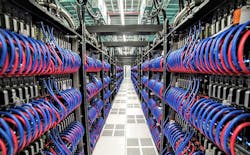The Exascale Era Begins, as Frontier Breaks Supercomputing Barrier
It’s official: The U.S. has its first exascale computing system, as the Frontier system at Oak Ridge National Laboratory in Tennessee exceeded 1.1 exaflop/s in the new Top500 list of the world’s most powerful supercomputers. Frontier becomes the first supercomputer to perform of one quintillion calculations per second — a billion billion calculations — in a set of standard tests used by researchers to rank supercomputers
“With an exact HPL score of 1.102 Exaflop/s, Frontier is not only the most powerful supercomputer to ever exist – it’s also the first true exascale machine,” said the Top500 announcement.
The system developed by the Department of Energy uses 8,730,112 cores. The new HPE Cray EX architecture combines 3rd Gen AMD EPYC CPUs optimized for HPC and AI with AMD Instinct 250X accelerators and Slingshot-11 interconnect.
“Frontier is ushering in a new era of exascale computing to solve the world’s biggest scientific challenges,” said Thomas Zacharia, Director of Oak Ridge National Lab. “This milestone offers just a preview of Frontier’s unmatched capability as a tool for scientific discovery. It is the result of more than a decade of collaboration among the national laboratories, academia and private industry, including DOE’s Exascale Computing Project, which is deploying the applications, software technologies, hardware and integration necessary to ensure impact at the exascale.”
Today’s milestone is the culmination of a quest begin in 2016, when the DOE formed the Exascale Computing Initiative (ECI to accelerate the research and development of exascale systems, framing the effort as a priority for both science and national security.
Here’s a look at notable coverage of today’s milestone:
- At Long Last, HPC Officially Breaks the Exascale Barrier: The Next Platform provides the big-picture context on the exascale accomplishment and its significance to high-performance computing. “Some of us have been waiting decades for this moment,” writes Timothy Prickett Morgan. “This scale, which has been very expensive and difficult to come by, gives researchers the ability to do larger and finer-grained simulations and an immense amount of AI training and inference as well, opening up all kinds of possibilities for the advancement of science and engineering.”
- U.S. Regains Top Spot, But Where is China?: The release of the Top500 is often seen in geopolitical terms, and that’s the lens embraced by The New York Times, which notes that Frontier unseated Japan’s Fugaku system atop the Top500 list. But the NYT also notes the elephant in the data hall. “But the crown has a caveat,” the Times writes. “Some experts believe that Frontier has been beaten in the exascale race by two systems in China. Operators of those systems have not submitted test results for evaluation.” The details of the Chinese systems have been reported by several outlets, most notably by Nicole Hemsoth (“China Has Already Reached Exascale – One Two Separate Systems”).
- Beyond Frontier: An Ascendant Moment for U.S. HPC?: Frontier’s exascale rating is part of a larger resurgence for American HPC, as noted by The Register. “The results mark a turning point for US supercomputing, which has waned in recent years. American systems now capture the first, fourth, fifth, seventh and eighth slots in the top ten of the Top500 list.”
- Strong Showing by AMD Processors: The Top500 provides bragging rights for hardware vendors, and the June 2022 version highlights the gains for AMD APYC processors in HPC. “AMD EPYC-powered systems now comprise five of the top ten supercomputers in the world, and ten of the top twenty,” notes Toms Hardware. “In fact, AMD’s EPYC is now in 94 of the Top500 supercomputers in the world, marking a steady increase over the 73 systems listed in November 2021 .”
- Power Meets Sustainability With LUMI: One of the most interesting new systems on the Top500 list is LUMI, which debits at number 3. The system was developed by the EuroHPC Joint Undertaking, a consortium of 10 European countries. The 151-petaflop system is expected to enable innovation in drug discovery, healthcare, and weather forecasting. Reflecting Europe’s green sensibilities, LUMI runs on 100% renewable hydroelectricity, uses free cooling and has an advanced heat recycling system, with its waste heat being used for local district heating.
About the Author



